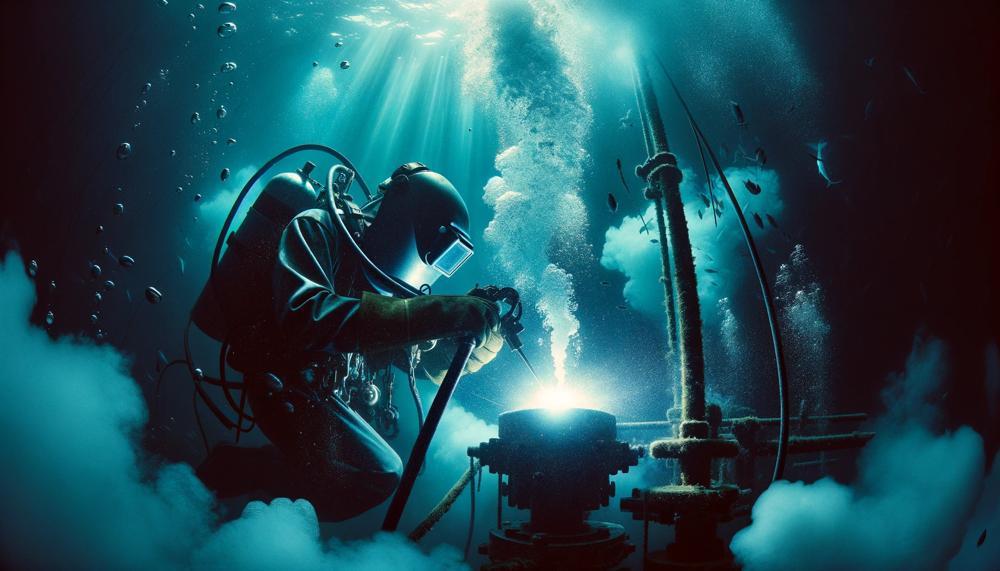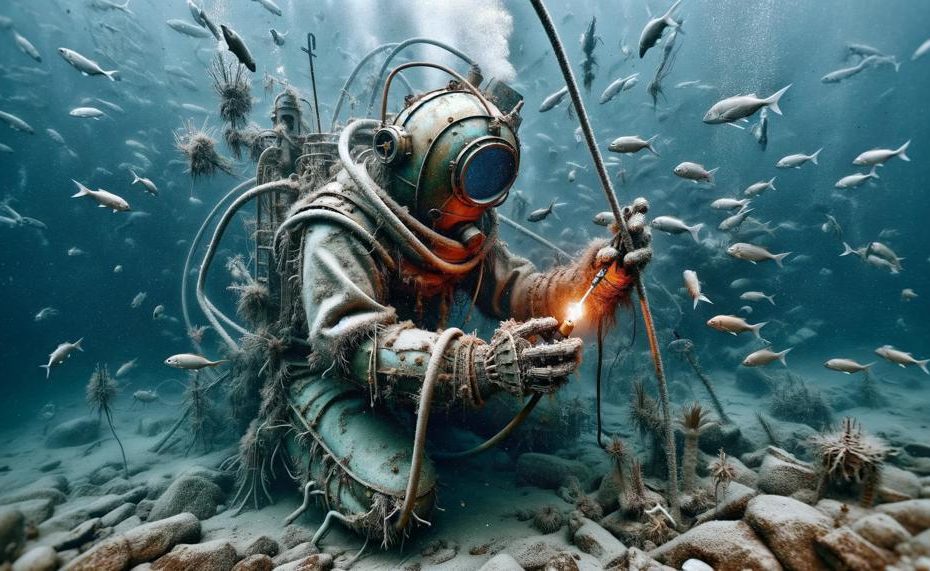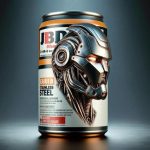The ocean, a vast and mysterious expanse, is not just a frontier for explorers and scientists but also a unique workplace for a group of skilled professionals known as underwater welders. These individuals combine the art of welding with the principles of diving, performing their tasks in an environment that is both mesmerizing and perilous.
This blog post aims to illuminate the depths to which these underwater artisans descend, shedding light on a profession that, while critical to various industries, remains shrouded in the depths of the sea.

Engaging in underwater welding is not just about skill and precision; it’s a venture into the deep, where pressure, darkness, and the unknown reign supreme.
So, how deep do underwater welders go?
Underwater welders typically work at depths of up to 300 feet (91 meters), but can go as deep as 1,000 feet. Underwater welding is often used to repair underwater pipelines, rigs, or platform structures. The work is done in a diving suit with specialized equipment, and each depth requires specific skills and equipment.
Dry welding uses a large gas chamber to cover the weldment, and is safer because it is welded in a dry gas phase. Wet welding is performed in open waters up to several hundred feet deep.
Underwater welders are subjected to dangerous pressure changes. A reduction in the ambient pressure surrounding the body can cause decompression sickness and arterial gas embolism. Industry investigations show that the underwater welding death rate has a high fatality rate estimated to be around 15%, making it 1,000 times more dangerous than working as a police officer.
So, let’s get started.
Contents
What is Underwater Welding?
Underwater welding, also known as hyperbaric welding, is a process where two pieces of metal are joined together underwater. It’s a crucial technique for repairing and constructing structures like ships, pipelines, and offshore platforms.
Unlike traditional welding, which happens in the open air, underwater welding demands unique skills, equipment, and safety measures due to the aquatic environment.
Key Differences Between Underwater and Traditional Welding
| Aspect | Underwater Welding | Traditional Welding |
| Environment | Performed underwater, with factors like water pressure and limited visibility affecting the process. | Conducted in open air, generally in more controlled and stable environments. |
| Equipment | Specialized equipment like dry chambers and specific electrodes are used to adapt to the wet conditions. | Uses standard welding gear suitable for air environments, with a broader range of accessible tools. |
| Skills and Training | Welders need extensive training in diving and underwater welding techniques, along with a deep understanding of safety protocols. | Focuses more on welding skills, with less emphasis on the surrounding environment’s challenges. |
| Risks and Challenges | High due to factors like pressure, visibility, and potential hazards from the marine environment. | Generally lower, with risks mainly related to the welding process itself, not the environment. |
| Applications | Primarily for underwater structures like pipelines and ship hulls. | Wide-ranging, including construction, manufacturing, and automotive industries. |
Dive Deeper into the Differences
Underwater welding is not just about joining metals; it’s an art that combines the precision of welding with the expertise of diving.
The unpredictable underwater world adds a layer of complexity, making this job one for the brave and skilled. Special electrodes, designed to strike an arc in water, showcase the innovation in this field.
Unlike the more predictable setup of traditional welding, underwater welders face a dynamic environment where every spark is a battle against the elements.
In essence, underwater welding is a testament to human ingenuity, adapting the principles of welding to the ocean’s depths.
Factors that Affect Depth for Underwater Welders
The major factors influencing the maximum depth at which underwater welders can operate encompass a range of both human and technical considerations, making this profession both challenging and fascinating.
| Factor | Description | Impact on Depth |
| Certification and Experience | Divers must undergo rigorous training and earn certification. Experience in varying conditions hones skill and judgement. | Enhances the safe operational depth limit. |
| Specialized Equipment | Advanced gear like diving suits and welding tools designed for deep water use. | Enables operations at greater depths by ensuring safety and functionality. |
| Environmental Conditions | Includes water pressure, visibility, and marine life which can vary drastically with depth. | Restricts or enables deeper dives based on safety and practicality. |
| Welding Method | Distinguishes between wet welding (up to 50 meters) and dry welding techniques (up to 600 meters). | Determines feasible operational depths and associated risks. |
| Health and Safety Protocols | Rigorous procedures for decompression, emergency handling, and dealing with hazardous gases. | Ensures welder’s safety, influencing the maximum depth for operations. |
Underwater welding, a profession that marries the finesse of welding with the audacity of deep-sea diving, pushes the boundaries of what’s achievable beneath the waves.
While the thrill of the deep blue calls to many, it’s the welder’s skill, gear, and respect for the ocean’s might that dictate how deep they can go.
General Depths for Underwater Welding Projects
Underwater welding, a blend of peril and precision, hinges on depth, each with its distinct demands and dangers. Here’s how the depths stack up and their impact on the welding craft:
| Depth Range | Environment | Impact on Welding |
| 10 to 30 feet (Shallow) | Close to surface, often in clear waters | Higher ease of access and lower risk; ideal for beginners or less complex tasks. |
| 30 to 100 feet (Mid-range) | Varying visibility, requiring moderate adaptability | Increased pressure and reduced temperature; demands greater skill and better equipment. |
| 100 to 1,000+ feet (Deep sea) | Extreme conditions with high pressure and cold | Requires top-tier gear, extensive training in decompression and emergency protocols; high-risk zone. |
At shallower depths, the water’s embrace is gentler, making it a playground for those new to the underwater welding scene or for tasks that need quick turnarounds. Yet, as we dive deeper, the water tightens its grip, squeezing not just the body but the very technique and tools one must employ.
At these profound depths, the dance with danger is a meticulous one, demanding not just skill but a courage bolstered by rigorous training and an arsenal of equipment designed to defy the depths.
Safety is the chant that echoes through all these realms, a reminder that beneath the surface, the waters are as unforgiving as they are vast. The deeper you go, the more the water whispers of the unknown, of hazards like erratic gas pockets and the ever-looming threat of decompression sickness.
It’s here, in the abyss, that the welder must not only confront the elements but also the limits of human endurance and technology.
Deeper Depths for Underwater Welders
When underwater welders submerge to greater depths, they encounter a series of heightened risks and challenges. The following table outlines these challenges along with their causes and potential impacts:
| Risk/Challenge | Cause | Potential Impact |
| Increased Pressure | Depth of Water | Physical Harm, Decompression Sickness |
| Diminished Visibility | Sediment, Lack of Light | Errors in Welding, Safety Hazards |
| Unpredictable Environment | Currents, Marine Life | Equipment Loss, Personal Harm |
| Cold Temperatures | Depth-Related Temperature Drop | Hypothermia, Reduced Dexterity |
| Complex Equipment Handling | Confined Spaces, Bulky Gear | Operational Errors, Physical Strain |
| Electric Shock Risk | Interaction of Water with Electricity | Injury, Fatality |
| Mental Stress | Isolation, High-stakes Environment | Impaired Judgment, Mental Health Issues |
Diving into the abyss, welders face an onslaught of physical and psychological tests. The pressure increases with every foot they descend, posing a threat not just to their bodily well-being but also to their mental fortitude. Darkness cloaks their work area, making their tasks not just hard, but perilous, as every spark beneath the waves is a reminder of the thin line they walk between the job and jeopardy.
Cold, another stealthy foe, seeps into their suits, nibbling away at their warmth and dexterity. And yet, amid these icy depths, they must remain nimble, handling complex machinery with precision – a Sisyphean task that demands more than mere skill; it demands resolve.
But the sea, she’s a fickle mistress, her currents unpredictable, her inhabitants curious and sometimes hostile. Each weld, each dive is a gamble against the sea’s caprice, with stakes higher than just the metallic structures they mend.
Thus, the underwater welder must not only be a master of the torch but also an adept seafarer, combatting not just the ocean’s might but also the lurking dread of isolation and the constant hum of danger that accompanies the deep.
Hazards of Working at Greater Depths
Diving into the abyss, underwater welders grapple with hazards unique to their deep-sea vocation.
The deeper the dive, the more perilous the journey becomes. Here, the silent world beneath the waves conceals risks that demand respect and rigorous preparation.
| Risk | Description | Preventive Measures |
| Drowning | The relentless sea, with its unpredictable currents and unforeseen events, poses a continual threat of drowning. | Rigorous training, constant vigilance, and reliable diving gear are crucial bulwarks against this ever-present danger. |
| Hypothermia | In the depths, the chill of the ocean creeps into bones and sinew, making hypothermia a silent, creeping adversary. | Insulated suits and regular checks on physical condition help in warding off the cold’s insidious advance. |
| Nitrogen Narcosis and Decompression Sickness | These treacherous conditions emerge from the body’s reaction to the pressures of the deep. Narcosis clouds the mind, while decompression sickness, or ‘the bends’, threatens upon ascent. | Careful ascent protocols and the use of appropriate gas mixtures can mitigate these deep-water demons. |
| External Hazards | Unseen currents, floating debris, and unexpected encounters with marine life weave a tapestry of risk. | Meticulous planning and situational awareness are key in navigating these external threats. |
| Electric Shock | Electricity, a fickle friend underwater, harbours a risk of shock amidst the conductive surroundings. | Rigorous equipment checks and adherence to safety standards ensure that this invisible threat is kept at bay. |
| Gas Toxicity | Breathing in the deep brings its own hazards, as the gases inhaled can turn toxic under pressure. | Monitoring gas mixtures and equipment functionality is vital to keep the invisible danger of gas toxicity in check. |
Special Equipment and Training Required for Deeper Dives
Underwater welders must arm themselves with specialised kit and knowledge to tackle the briny deep.
Their prep is a blend of the right gear and stern training, shaping them into sea’s fine metal fusers.
Equipment Essentials:
| Equipment | Use | Details |
| Diving Helmet | Protection and Breathing | Vital for eye and face shield; comes in types like open circuit, reclaim, and free-flow. |
| Welding Screen and Electrodes | Welding Accuracy | Guards eyes; electrodes made for marine use, water-resistant, vary by steel type. |
| Drysuits and Coveralls | Protection | Guard against cold, molten splashes; made from neoprene, rubber, or shell materials. |
| Rubber Gloves | Safety | Worn over latex gloves to prevent water ingress, essential for handling equipment. |
| Stinger | Electrode Handling | Lightweight, requires comfort for reduced fatigue; specific training recommended. |
| Underwater Welding Machine | Power Supply | Must be adaptable for marine use, with features like high yield strength and water resistance. |
Training Touchstones:
Underwater welders must dive into rigorous courses before plunging into the depths. Mastery in both welding and diving is non-negotiable. Here’s what they need:
- Certified Diving Skills: Dive training is foundational, covering everything from safety protocols to effective underwater communication.
- Welding Prowess: Hands-on experience in dry environments before progressing to submerged settings ensures skillful handling of marine welding tasks.
- Equipment Familiarity: Intimate knowledge of gear specifics and operational nuances prevents mishaps and ensures effective underwater work.
- Safety Practices: Understanding risks such as electric shock, gas toxicity, and hypothermia is crucial; safety drills are as vital as the welding itself.
- Environmental Adaptation: Recognising and adapting to underwater conditions prepares welders for the unpredictable nature of sea work.
Proper gear and sharp skills ensure that underwater welders not only tackle their tasks but also respect and navigate the marine world’s formidable forces.
Conclusion
The field of underwater welding, which combines the excitement of deep-sea diving with the accuracy of welding, is a monument to human creativity and daring. This specialized area demonstrates a combination of expertise, technology, and pure boldness as it pushes the limits of what is possible under the waves.
Divers work at depths that range from 10 feet in the shallows to 1,000 feet in the deepest abyss, with each depth layer requiring a different mix of abilities, gear, and mental toughness.
These underwater artists can operate in some of the most difficult conditions on Earth, where pressure, visibility, and the marine life are continuous hazards, thanks to the combination of cutting-edge technology and stringent safety procedures.
Deep-sea welding is a perilous dance with the depths, where the ocean’s tremendous pressure and the dark, unexpected circumstances put the welders’ skill and commitment to the test. It’s not just about connecting metal underwater. With specialized training in welding and diving and an equipment arsenal designed specifically for the aquatic theater, these people are prepared for any number of hazards.
Underwater welders are a unique species whose job is essential to preserving the infrastructure that support global economies, from fending off the grip of the cold to managing the risks of electric shock and decompression sickness.
Forging steel in the ocean’s depths to preserve the integrity of crucial undersea infrastructure is essentially an act of bravery, tenacity, and extraordinary skill performed by underwater welders.





